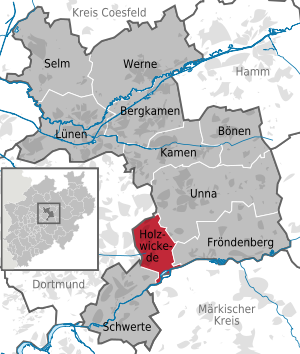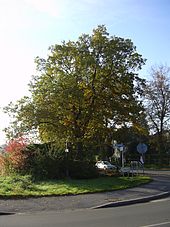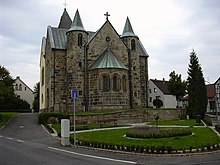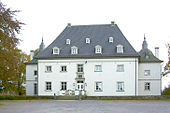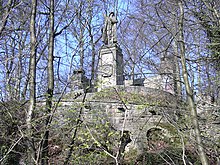Holzwickede
| coat of arms | Germany map | |
|---|---|---|
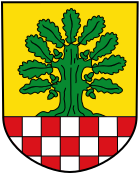
|
Coordinates: 51 ° 30 ' N , 7 ° 37' E |
|
| Basic data | ||
| State : | North Rhine-Westphalia | |
| Administrative region : | Arnsberg | |
| Circle : | Unna | |
| Height : | 125 m above sea level NHN | |
| Area : | 22.36 km 2 | |
| Residents: | 17,076 (Dec. 31, 2019) | |
| Population density : | 764 inhabitants per km 2 | |
| Postal code : | 59439 | |
| Area code : | 02301 | |
| License plate : | UN, LH, LÜN | |
| Community key : | 05 9 78 016 | |
| LOCODE : | DE HZE | |
| Community structure: | Hengsen, Holzwickede, Opherdicke | |
| Address of the municipal administration: |
Allee 5 59439 Holzwickede |
|
| Website : | ||
| Mayoress : | Ulrike Drossel (Citizens' Block) | |
| Location of the municipality of Holzwickede in the Unna district | ||
The municipality Holzwickede ( Low German : Hol (t) wicker) is located on the eastern edge of the Ruhr area , North Rhine-Westphalia , and is a kreisangehorige community of the district of Unna in Arnsberg .
geography
Spatial location
The municipality of Holzwickede is bordered in the north by the Dortmund ridge on the old federal highway 1 and the Dortmund airport and in the south by the Ruhr . To the west, the south-east Dortmund and Schwerte form the border, and to the east of Holzwickede are Unna and the western districts of Fröndenberg / Ruhr .
The ridge of the Ardey Mountains runs through the municipality . The Emscher has its source in Holzwickede.
The lowest point of the municipality is in the northeast, where the Holzwickeder Bach leaves the municipality. The highest point carries a radio system of the Bundeswehr and is on the western part of the Ardeys in Hengsen.
Districts
The districts of Hengsen (8.03 km²) and Opherdicke (spoken: Op-Hérdicke, 4.62 km²) form the southern part of the municipality, the old town of Holzwickede (9.76 km²) the northern part.
The town centers of Hengsen and Opherdicke lie on the Haarstrang (Herdicker Haar) . The Hengser local area extends in the south to the Ruhr , Opherdicke also extends almost to the Ruhr. A large part of these location areas is formed by a training area of the army assigned.
The old town of Holzwickede is made up of the parts "Altes Dorf" (the original Holzwickede), Dudenroth, Rausingen and Natorp and lies between the ridge of the Ardey Mountains and the Dortmund ridge in the Emscher lowlands. Until July 31, 1929, a western strip of Rausingen belonged to Sölde , the rest of the municipal area of which was incorporated into Dortmund at the same time.
In addition to these districts, there are other settlement area names: Keller, Brauck, Ostendorf, Alte Kolonie, Hohenlicht.
Neighboring communities
The following cities share a border with Holzwickede (clockwise from the north): Dortmund , Unna , Fröndenberg / Ruhr , Iserlohn , Schwerte
history
The history of Holzwickede is naturally closely linked to the history of the surrounding area, so the history of the Ruhr area is also worth reading along with the history of Holzwickede .
The area of the later municipality of Holzwickede was already populated in the Neolithic Age (5000–2000 BC). This is proven by finds such as a sharpened plow wedge that was found in the Hengsen district and is now (2004) kept in the Museum of Art and Cultural History in Dortmund .
Around the turn of the century , Roman troops occupied the land crown in Holzwickede alongside other strategically important points between the Ruhr and Lippe. According to legend, between 300 and 400 AD the Nibelungs used the Roman path at the height of the Ardey Mountains (through Hengsen and Opherdicke) on their way to Soest.
A section of the famous Way of St. James to Santiago de Compostela also led across the ridge of the Ardey Mountains from around the High Middle Ages . The pilgrims came from the Hellweg in Unna on the so-called small Hellweg between Opherdicke and Ostendorf. From here it went through Opherdicke and Hengsen to Breckerfeld , where the pilgrims gathered in larger groups to continue their journey. A chapel with a statue of James is said to have stood in Hengsen at the time .
The first known documentary mention is found in 1100 for Opherdicke in a property register and 1150 for Hengsen (as Hegeninchusen ) in documents from the Werden monastery (near Essen ). A castle in Opherdicke was first mentioned in 1176.
The first coal finds are proven in 1575 in Opherdicke. Holzwickede's mining history lasted until May 31, 1951, when the Caroline colliery was finally shut down and almost 500 miners lost their jobs (or were partly relocated to other pits).
In 1825 the four farmers' communities Dudenroth , Rausingen , Holzwickede and Natorp officially merged to form the municipality (today's district ) Holzwickede. In 1929, Holzwickede was expanded to include part of Sölde as part of the municipal reorganization in the Prussian province of Westphalia . This included above all the site of the Freiberg colliery (today VW works Vincenz Wiederholt ). In its current form, Holzwickede only came into being through the municipal reorganization in 1968, when the previously independent municipalities of Hengsen, Holzwickede and Opherdicke were merged into one larger municipality .
On December 15, 1860, Holzwickede became a train station on the Dortmund - Soest railway line. The line was built from 1853 to 1855, but the trains did not initially stop in Holzwickede. One year after the station, Holzwickede received the first post office in 1861. In 1867 Holzwickede became a nationally important railway junction with a marshalling yard that was almost completely demolished today when another railway line from Hengstey via Schwerte to Holzwickede was put into operation . The railway line from Schwerte along the Ruhr to Warburg also runs through the Holzwickeder area; Today's Bahnwald nature reserve used to be home to the eastern part of the Geisecke (Ruhr) marshalling yard, which was already completely demolished on this route . The connection of private households and the Holzwickeder street lighting to the public power grid took place in 1907, the connection to the public water supply also at the beginning of the 20th century.
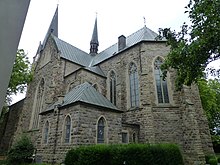
In the spring of 1966, anti-aircraft missiles of the anti-aircraft missile battalion 21 of the Bundeswehr were stationed in Opherdicke . Nuclear warheads were also available for this weapon system. They were under guard by the 66th US Army Artillery Detachment (66th USAAD). The stationing did not meet with the undivided approval of the Holzwicked population. In 1987 the Nike Hercules weapon system was replaced by the Patriot mobile anti-aircraft missile system. In 2004 the location was closed.
In 1987 the community of Holzwickede had 15,878 inhabitants.
Incorporations
On August 1, 1929, Holzwickede was expanded to include part of the dissolved municipality of Sölde (eastern Rausingen). On January 1, 1968, Hengsen and Opherdicke were incorporated.
Knights and noble estates
The following mansions were located in the area of today's municipality of Holzwickede: House Opherdicke in Opherdicke, House Dudenroth in Holzwickede, House Ruhr / Lappenhausen , House Vierbecke , Rittergut Hegeninghusen and House Linscheid in Hengsen.
Only the Opherdicke house is preserved of these goods. A wall fragment of the Ruhr house still exists in the forest on the Ruhr, Dudenroth house was demolished in the 20th century and only the four parts of the Vierbecke house can be guessed at on the site of the training area.
History of Hengsen
After the rural community regulations for the province of Westphalia came into force (on October 31, 1843), the following community leaders / mayors were in Hengsen until the merger in 1968:
- 1844–1850: Strictness (farmer)
- 1850–1851: Schulte-Hengsen (farmer)
- 1851–1854: Flunkert (farmer)
- 1854–1859: Fiene (farmer)
- 1859–1871: Wilhelm Westermann (farmer)
- 1871–1887: Friedrich Schulte-Hengsen († 1887, farmer)
- 1887–1893: Wilhelm Westermann (farmer)
- 1893–1917: Heinrich Kissing (blacksmith)
- 1917–1923: Karl Schulze-Braucks
- 1923–1924: Wilhelm Riedel
- 1924–1930: Hugo Strenge (farmer)
- 1930–1933: Ludwin Adrian (miner, SPD)
- 1933–1933: Wilhelm Riedel (mountain invalid, appointed by NSDAP)
- 1933–1939: Fritz König (NSDAP)
- 1939–1945: Wilhelm Riedel
- 1945–1945: Rabe (NSDAP)
- 1945–1958: Ludwig Adrian († 1958)
- 1958–1963: Gustav Brauckmann (SPD)
- 1963–1968: Heinrich Beining (SPD)
History of Holzwickede
After the rural community ordinance for the province of Westphalia came into force (on October 31, 1843), the following community leaders / mayors existed in Holzwickede until the merger in 1968:
- 1843–1850: Middelschulte (farmer)
- 1850–1859: Friedrich Stehfen (farmer)
- 1859–1881: Gottfried Hiddemann (1812–1893; farmer)
- 1881–1893: Wilhelm Barenbräucker (farmer)
- 1893–1911: Ludwig Büddemann (farmer)
- 1911–1914: Wilhelm Schröer (farmer)
- 1914–1924: Karl Luicke (businessman)
- 1924–1929: Theodor Rieke (businessman)
- 1929–1931: Karl Luicke
- 1931–1933: Theodor Rieke
- 1933–1939: Friedrich Wilhelm Spring (1895–1970; landowner, NSDAP)
- 1939–1941: Paul Geldmacher (as deputy, NSDAP)
- 1941–1945: Wellemeyer (as deputy, NSDAP)
- 1945–1946: Josef Kiel (appointed by British occupation, SPD)
- 1946–1968: Erwin Heller (SPD)
History of Opherdicke
After the rural community regulations for the province of Westphalia came into force (on October 31, 1843), the following community leaders / mayors were in Opherdicke until the merger in 1968:
- 1843–18 ??: The first community leaders are not known, due to the visible practice from 1888 onwards, the office was presumably held by the respective landlord at Haus Opherdicke
- 18 ?? - 1888: Hermann von Lilien († 1888)
- 1888–1906: Franz Kaspar von Lilien († 1906)
- 1906–1921: Karl Saatmann (farmer)
- 1921–1935: Theodor Regenbogen (resignation 1935)
- 1935–1945: Josef Höber (NSDAP)
- 1945–1948: Theodor Regenbogen
- 1948–1956: Fritz Kötter (farmer)
- 1956–1968: Josef Wortmann (CDU)
Politics and administration
Municipal council
The council of the municipality consists of 40 seats. Since the local elections on May 25, 2014, with a turnout of 55.61%, there have been five parliamentary groups made up of four parties and an electoral association . The following table shows the distribution of seats after the previous elections.
| Distribution of seats in the municipal council | ||||||
|---|---|---|---|---|---|---|
| SPD | CDU | Civic bloc | FDP | Green | young list | |
| 1999 | 12 | 10 (9) * | 4th | 2 | 2 | 2 (3) * |
| 2004 | 16 | 10 | 6th | 3 | 3 | 2 |
| 2009 | 16 | 8th | 5 | 5 | 4th | 2 |
| 2014 | 14th | 9 | 8th | 4th | 5 | - |
(*) Timon Becker, former CDU member, switched to the Jungeliste parliamentary group in 1999
| Results of the local elections from 1975 | |||||||
| year | SPD | CDU | BBL 1 | Green 2 | FDP | JL | Flat share |
|---|---|---|---|---|---|---|---|
| 1975 | 44.7 | 35.6 | 7.1 | 12.7 | |||
| 1979 | 49.3 | 34.7 | 7.9 | 8.1 | |||
| 1984 3 | 53.8 | 36.4 | 7.3 | ||||
| 1989 | 49.0 | 29.2 | 11.9 | 9.8 | |||
| 1994 | 41.9 | 32.7 | 12.2 | 8.2 | 4.9 | ||
| 1999 | 38.3 | 30.7 | 12.2 | 4.5 | 7.3 | 7.0 | |
| 2004 | 40.9 | 24.5 | 15.2 | 6.6 | 7.5 | 5.3 | |
| 2009 | 40.2 | 21.4 | 12.1 | 10.2 | 12.0 | 4.0 | |
| 2014 | 35.0 | 22.6 | 19.2 | 12.5 | 10.7 | ||
The above list only includes parties and voter communities that received at least 1.95 percent of the votes in the respective election.
1 BBL (Bürgerblock): 1994: HBB, 1999 and 2004: BBL, 2009: BBLH
2 Greens: B'90 / Greens
3 1984: additional: Individual applicants: 2.5%
mayor
The current mayor is Ulrike Drossel (BBL). It was elected in September 2015 with 59.84 percent of the vote. Competitor Michael Klimziak (SPD) received 40.16 percent.
The list of Holzwickeder mayors since 1950:
- 1950–1967: Erwin Heller (WG), last mayor of Holzwickedes before merging with Hengsen and Opherdicke
- 1967–1968: Walter Adelt (SPD) († 2015) (appointed until the first mayoral election of the new municipality)
- 1968–1969: Erwin Heller (flat share)
- 1969–1975: Josef Wortmann
- 1975–1989: Heinrich Schürhoff
- 1989–1999: Margret Mader (SPD)
- 1999-2015: Jenz Rother (SPD)
- 2015– : Ulrike Drossel (BBL)
The last own mayor of Hengsen was Heinrich Beining, the last mayor of Opherdicker was Josef Wortmann.
coat of arms
The coat of arms of Holzwickede represents an old landmark in Holzwickede, the Hilgenbaum . A nine-leaved green oak in front of a golden background stands on a red and silver checkerboard pattern as a symbol of the (former) affiliation to the county of Mark .
Town twinning
Holzwickede has two town twinning partnerships. The older one has existed since 1977/78 with the French Louviers . Since 1986/87 there has also been a town partnership with the English seaside resort Weymouth .
In addition, since November 1990, the community has also had a friendship with the city of Colditz in Saxony .
All town twinning is maintained by the local twinning associations. The Franco-German partnership is in the hands of the Franco-German Society Holzwickede, better known as the "Freundeskreis Holzwickede-Louviers". With over 250 members, it is the largest cultural association in Holzwickede.
Denomination statistics
According to the 2011 census , 42.3% of the population in 2011 were Protestant , 30.2% Roman Catholic and 27.5% were non-denominational , belonged to another religious community or did not provide any information. The number of Catholics, and especially Protestants, has fallen since then. According to the municipal statistics (as of December 31, 2018) 37.1% (6,449) were Protestant, 28.7% (4,978) were Catholic and 35.2% (5,942 people) were communityless or without information.
Culture and sights
nature
The first to be mentioned here is the Hilgenbaum, the coat of arms tree of the municipality of Holzwickede . To the east of the old town center there used to be an ancient oak, which got its name from the fact that newsletters (Hilgen) were attached there. Other sources interpret the name as a holy (= hilgen) tree. After the historic old tree fell victim to a fire, a new tree was planted in (almost) the same place at the beginning of the 20th century. It is located on the SE side of the Massener Straße / Goethestraße intersection, while the documents indicate that the first Hilgenbaum was "on the intersection".
As the source community of the Emscher, Holzwickede is home to the Emscherquellhof with the Emscher source . The farm was bought and repaired by the Emschergenossenschaft in 2003 .
The Schöne Flöte is a small wooded area on the course of the Holzwickeder Bach from the outdoor pool "Schöne Flöte" northwards (along the route of the A1) to the source of the brook. A hiking trail for pedestrians and cyclists leads through the forest to the crossing of Holzwickeder Straße.
The brook valley of the Holzwickede brook is also part of the historic Holzwickede mining circuit, which is well worth seeing .
With the Am Oelpfad facility , Holzwickede has an allotment garden that is well worth seeing. Since 1996 (with only one interruption in 2008) the facility has been repeatedly recognized as the "most beautiful facility in the Unna district" by the Hamm-Unna district association of allotment gardeners (as of 2016).
building
Special buildings can be seen above all in the district of Opherdicke. The Protestant church Opherdicke is the oldest building in the community, a small Romanesque basilica that was built between 1220 and 1250. The tower is dated to the time before the turn of the first millennium.
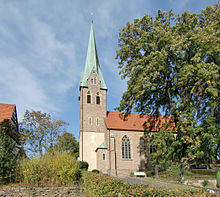
A little further to the east, also in Opherdicke, is the Haus Opherdicke moated castle , which, after a varied history, came into the hands of the Unna district in July 1980 and, following successful restoration, is now used as an event location. The house was first mentioned in history as Burg Opherdicke in 1182. From 1663 to 1687 the old moated castle was rebuilt and received its present form. In the 18th and 19th centuries the farm and auxiliary buildings were built, which still border the inner courtyard today (2014) in an unchanged form. The last noble resident of the moated castle was the von Lilien family , who came from Werl .
From the Opherdicke house, hikers can enjoy a beautiful view of the Ruhr valley .
The Catholic Church of Our Lady in the center of the village was built in 1904, followed by the Evangelical Church on the market in 1907 . Both buildings have been a listed building since 1984.
Monuments
In the southwest of the municipality is the 130 memorial (also basement head memorial ). On the steep slope of the cellar head towards the Ruhr valley, the regimental memorial was inaugurated on September 1, 1929 for those of the 1st Lorraine Infantry Regiment No. 130 ( popularly "130s" ) who died in the First World War .
This memorial was built according to a design by the Berlin sculptor Fritz Richter-Elsner from 1926 to 1929 in the spirit of the time in honor and in memory of the fallen soldiers of the regiment, among whom were many local soldiers. The initiator and donor of the monument was the 130 soldiers' association , formed from the surviving members of the regiment.
For a long time, the cellar head was a destination for excursions and a local recreation area. Today a larger number of people visit the cellar head only at Whitsun, because since 1979 the association for the preservation and care of the cellar head memorial has been celebrating a peace festival there every Whitsunday.
The anti-war memorial erected in Emscherpark in the 1960s, designed by the artist Josef Baron , who lives in Unna , was originally intended to be relocated to a different location within the community. After the artist turned against hiding the object in a secluded place, a replica of the work was erected in the forum of the Clara-Schumann-Gymnasium in 2009. The original was dismantled in August 2009 and set up again in 2012 in Munster in the Lüneburg Heath.
Sports
Holzwickede has many sports clubs with a wide variety of activities. The greatest success of a football team is in 1976 the title of German amateur football champion of the Holzwickede 1912/29 game association (HSV) . The largest sports club is the Holzwickede gymnastics community with around 1100 members. The TGH is a multi-disciplinary sports club that unites athletics, badminton, ball games, gymnastics, gymnastics and prevention / rehabilitation sports under one roof.
On the hairline between Hengsen and Opherdicke, the Holzwickede Joboxers, a former baseball Bundesliga team, are based in Holzwickede. Baseball in Holzwickede has its origins in the stationing of US troops in the community (1960–1985).
On the Ruhr Valley Railway, the MSC Holzwickede organized motorcycle grass track races on Bundeswehr grounds. The race track was between Dortmund and Unna.
In Holzwickede are the 1950 Holzwickede TTC also table tennis Active home. The first men's team currently plays in the Oberliga (fourth highest league), in which the former German champion also plays in the men's doubles and singles with the seniors, Bernd Sonntag .
Holzwickede also has a canoe club, but its boathouse is in Fröndenberg on the Ruhr .
Tennis is practiced intensively in Holzwickede. The largest association is the TuS Elch 1963 Holzwickede e. V., which is one of the largest clubs in the region with 12 outdoor sand courts on a green tennis facility in the north of Holzwickeder and around 300 members.
Montanhydraulikstadion
The Montanhydraulikstadion (formerly Emscherstadion ) is the central competition venue for footballers, track and field athletes and other outdoor athletes in Holzwickede. With a capacity of around 5000 spectators, it is the largest in the Unna district . It has a covered main grandstand.
The high point in its history so far was the amateur championship of SV Holzwickede in 1976 and the hosting of the women's A international match against China in the late 1990s. The BVB amateurs use this stadium when their own Rote Erde stadium is not available.
Regular events
- Since 1979 the association for the preservation and care of the basement head memorial has been celebrating a peace festival there every Pentecost Sunday .
- In early summer on the last weekend in June, jump! until 2007 the largest voluntary festival in North Rhine-Westphalia, organized by the DLRG Holzwickede and many helpers, took place in the Holzwickeder outdoor pool, the "Schönen Flöte".
- From 1999 to 2012, the Holzwickede Joboxers held an annual pool and cocktail party with summer splash in the Holzwickeder outdoor pool .
- Since 1951 the Bürgererschützenverein 1865 e. V. holds its rifle festival every first Sunday weekend in July - in the past at Haus Dudenroth, today in Louviers square.
- Since 2007, Jörg Hegemann from Witten has been introducing German and European blues musicians on the piano (Boogie Woogie) with ever-growing popularity every summer in the old barn of Haus Opherdicke.
Economy and Infrastructure
Since around the middle of the 19th century, Holzwickede was characterized by mining and railways. The Caroline colliery was the last colliery that still mined in Holzwickede. A residential area has been under construction on the former colliery site since 2006. In the north of the community, a new commercial area is currently being built in the immediate vicinity of Dortmund Airport .
The municipality of Holzwickede has the highest average primary income per inhabitant in the Unna district. In a national comparison, it was ranked 29th among the 396 municipalities in North Rhine-Westphalia in terms of average disposable income in 2016. This makes Holzwickede one of the highest income communities in the state.
traffic
Holzwickede can be reached by road, rail and air. The A 44 (Aachen-Düsseldorf-Kassel) and A 1 (Puttgarden-Euskirchen-Saarbrücken) motorways run through the town . There is a separate exit for Holzwickede on the A 44.
In addition, the following federal (B) and state roads (L) run through Holzwickede :
- The B 1 discharges - by Dortmund Coming - at the junction Holzwickede in the A 44th
- The L 673 runs north of the Ruhr and crosses the south of Holzwickede. It leads from the junction with the L 675 in Hagen via Schwerte , Fröndenberg / Ruhr and via Wickede to the B 516 in the Enser district of Bremen.
- The L 677 begins at the L 821 and crosses Holzwickede in a north-south direction. About the swords finally district Geisecke it reaches the L 676 in Iserlohn district Rheinen.
- The L 678 begins at the A-1 junction Kamen-Zentrum as an extension of the B 233 coming from the north . It leads over Unna and Opherdicke to Hengsen, where it ends at the L 677.
- The L 821 begins at the B 234 in the Dortmund district Aplerbeck . In Holzwickede it forms the northern border to Dortmund and Unna . Then it leads in a northerly direction via Unna- Massen , Kamen - Methler and Bergkamen - Oberaden to the L 736 in Bergkamen-Heil.
The Holzwickede / Dortmund Airport train station is on the Hagen – Hamm and Dortmund – Soest railway lines .
Dortmund Airport is located north of the municipality and is within walking distance. A shuttle bus runs from Holzwickede train station to the airport.
The Hengsen-Opherdicke glider airfield is located in the south of the Hengsen district . There is the Luftsportverein Unna-Schwerte e. V. is at home.
education
The municipality of Holzwickede is home to four primary schools . The Catholic Aloysius School , the Protestant Dudenroth School , as well as the North School and the Paul Gerhardt School as community elementary schools . The Clara-Schumann - Gymnasium and the Josef-Reding - Schule are located in the school center . The community also houses the Karl Brauckmann School , a special needs school in the Unna district with a focus on intellectual development .
Medical supplies
Medical care is provided by the hospitals in Schwerte, Unna and Dortmund.
Personalities
Sons and daughters of the church
- Agnes von der Vierbecke (? –1378) tried in vain on October 4th, 1378 to gain access to Dortmund's troops from the Counts of the Mark . She was burned as a traitor in Dortmund on the same day .
- Friedrich Stehfen (1809–1879) founded the “Hellweger Erziehungsheim ” in 1863 to care for orphans . By the time it was dissolved (1942), over 2000 orphans had been admitted there. In 1872, Stehfen also founded a teacher training facility in Holzwickede, which was then called the preparatory institute.
- Julius Bergmann (1839–1904), philosopher
- Karl Brauckmann (1862–1938) established one of the first special schools for the hard of hearing and deaf in Jena and advocated special instruction for these people.
- Hermann Mandel (1882–1946), theologian and religious scholar
- Hermann Strathmann (1882–1966), Protestant theologian and politician
- Wilhelm Schleef (1889–1968), teacher, writer and local history researcher; Publications and a. Dortmund dictionary, history of the Sölde farming community and Düet es dat Bauk van Schulte-Wuordelbuk
- Wilhelm Deist (1898–1953) was a German district administrator and member of the state parliament of North Rhine-Westphalia.
- Gustav Schmidt (1908–1933), student in Braunschweig, member of the socialist student movement, victim of the Rieseberg murders
- Max Wegner (1915–1944) was a German writer who was influenced by National Socialism.
- Egon Lampersbach (1917–1982), politician (CDU), member of the Bundestag
- Willi Dißmann (born June 30, 1920 in Holzwickede; † unknown), author of children's and young people's books influenced by National Socialism between 1938 and 1943 (including Drei wird Pimpfe, Der Pimpfenkrieg, boys and girls in war (“He's still Pimpf, but soon he will do his duty in the victorious army of the Fiihrer ”), a murderous guy, the Kalle! )
- Johannes Dörmann (1922–2009), Catholic theologian and missiologist
- Herbert Wilhelmy (born December 13, 1927, † March 4, 2012 in Holzwickede) was a local researcher and author of numerous writings on the history of Holzwickede.
- Beda Vickermann OFM (1934-2015), b. in Opherdicke, Franciscan ("Pater Beda"), campaigned for the poor in South America
- Klaus Brüngel (* 1949), composer, has written numerous musical works, especially in e-book format.
- Burkhard Schröder (* 1952), journalist and writer from Berlin
Other personalities connected to the community
- Dean Alois Gemmeke (born October 5, 1872, † December 30, 1953 in Holzwickede) has been a pastor in Holzwickede for almost 57 years since the founding of the Catholic community in Holzwickede.
- Herbert Schlieper († 1993) was pastor of the Protestant parish Opherdicke from 1942 to 1972 and had a great influence during his time.
- The writer Walter Vollmer (* 1903, † 1965) lived in Holzwickede from 1933 to 1937. The novels Land an der Ruhr and Die Schenke zur Ewigen Liebe , published in 1935, were probably written in Holzwickede.
- The former professional soccer player and national player Hoppy Kurrat ran a restaurant in Holzwickede (Hoppys Treff) .
- Vincenz Wiederholt founded the "VW works Vincenz Wiederholt" in Holzwickede. Today a street is named after him.
- The former professional soccer player Martin Kree runs an IT training center (New Horizons) in Holzwickede .
- Joachim Huske , German mining engineer and author of many publications on mining history, lives in Holzwickede.
- Christianasche , actor, known from the Cologne crime scene, lived in Holzwickede until his death in 2013.
Web links
- Website of the municipality of Holzwickede
- Holzwickede in the Westphalia Culture Atlas
Individual evidence
- ↑ Population of the municipalities of North Rhine-Westphalia on December 31, 2019 - update of the population based on the census of May 9, 2011. State Office for Information and Technology North Rhine-Westphalia (IT.NRW), accessed on June 17, 2020 . ( Help on this )
- ^ Schleef, Wilhelm: Dortmund dictionary. 1967. XXII, 298 pp. Ln. (PDF; 3.9 MB)
- ↑ Stephanie Reekers: The regional development of the districts and communities of Westphalia 1817-1967 . Aschendorff, Münster (Westphalia) 1977, ISBN 3-402-05875-8 .
- ^ State Office for Data Processing and Statistics (ed.): Population and private households as well as buildings and apartments. Selected results for parts of the community. Arnsberg administrative district . Düsseldorf 1990, p. 272 .
- ↑ Stephanie Reekers: The regional development of the districts and communities of Westphalia 1817-1967 . Aschendorff, Münster Westfalen 1977, ISBN 3-402-05875-8 , p. 249 .
- ↑ Martin Bünermann: The communities of the first reorganization program in North Rhine-Westphalia . Deutscher Gemeindeverlag, Cologne 1970, p. 64 .
- ↑ Active Seniors, Issue 52, Introduction to "Holzwickede's Knight Seats"
- ↑ a b c Willy Timm: History of the community Holzwickede. With its districts of Hengsen, Holzwickede and Opherdicke, Holzwickede 1988.
- ↑ Directories of the results of the local elections for the State of North Rhine-Westphalia (LDS NRW) from 1975 to 2009
- ↑ Elective profile of the State Office for Data Processing and Statistics NW ( Memento of the original from June 6, 2017 in the Internet Archive ) Info: The archive link was automatically inserted and not yet checked. Please check the original and archive link according to the instructions and then remove this notice.
- ↑ Election results 1999 ( page no longer available , search in web archives ) Info: The link was automatically marked as defective. Please check the link according to the instructions and then remove this notice. (PDF; 5.9 MB)
- ↑ 2004 election results ( page no longer available , search in web archives ) Info: The link was automatically marked as defective. Please check the link according to the instructions and then remove this notice. (PDF; 7 MB)
- ↑ Election results 2009 ( page no longer available , search in web archives ) Info: The link was automatically marked as defective. Please check the link according to the instructions and then remove this notice. (PDF; 3.5 MB)
- ↑ Archived copy ( memento of the original dated February 11, 2016 in the Internet Archive ) Info: The archive link was inserted automatically and has not yet been checked. Please check the original and archive link according to the instructions and then remove this notice.
- ↑ Holzwickede Religion , 2011 census
- ↑ The number of inhabitants is developing positively again in 2018 , emscherblog.de, accessed on January 30, 2020
- ↑ Memorial should go - artist blocks himself. In: WAZ , October 5, 2007 (offline)
- ↑ http://www.derwesten.de/staedte/nachrichten-aus-unna-kamen-bergkamen-holzwickede-und-boenen/mahnmal-soll-erinnerungen-wach-halten-id236658.html (offline)
- ↑ http://www.derwesten.de/staedte/nachrichten-aus-unna-kamen-bergkamen-holzwickede-und-boenen/mahnmal-im-emscherpark-zersaegt-id69065.html (offline)
- ↑ http://www.geschichtswerkstatt-holzwickede.de/uploads/media/Josef_Baron_II_A5_01.pdf
- ↑ http://www.tus-elch-holzwickede.de/
- ↑ Hellweger Anzeiger, Holzwickede edition, September 10, 2012, p. 9
- ↑ Primary income in NRW per inhabitant in 2016 by municipalities
- ↑ http://www.lsv-unna-schwerte.de/

